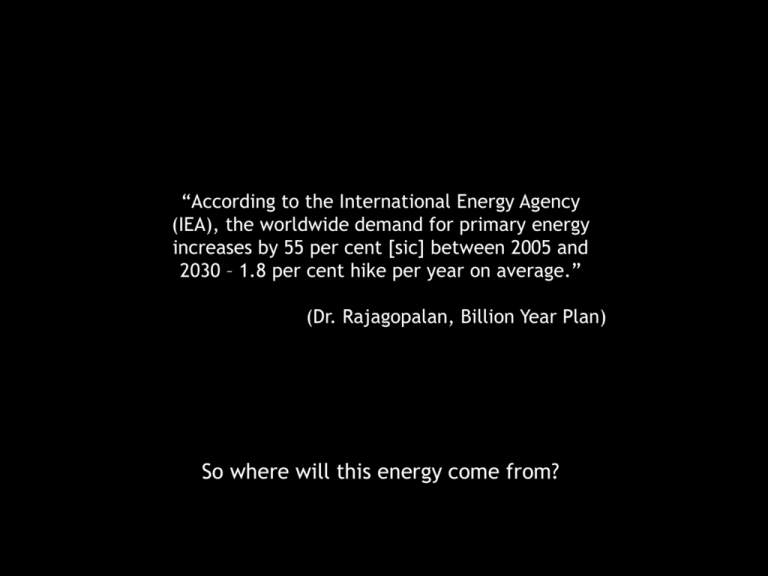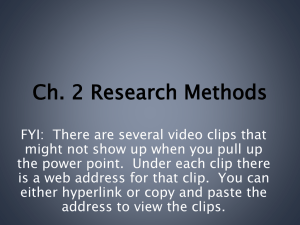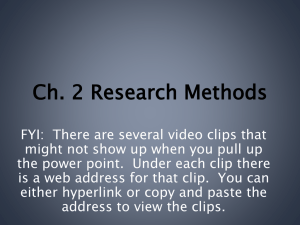Space-Based Power Oil Alternative Project
advertisement

“According to the International Energy Agency (IEA), the worldwide demand for primary energy increases by 55 per cent [sic] between 2005 and 2030 – 1.8 per cent hike per year on average.” (Dr. Rajagopalan, Billion Year Plan) So where will this energy come from? Space-Based Power Presented By: Bobby Schneider Space-Based Solar And Solar Wind Oil Alternatives: Space-Based Power The energy solution that is literally out of this world. Just as space seems to be endless, so is the power that it has to offer. Providing energy 24 hours a day, 7 days a week, nations around the globe have found that space is a promising source of alternative energy. With the necessary money and technology, a future of Solar power and Solar Wind from space could very well be the answer to Earth’s seemingly unsolvable energy crisis. Content: -Key Actors and Stakeholders -Space-Based Solar Power -What is it? -How it Works -History -Present-Day Project -Space-Based Solar Wind -What is it? -How it Works -History -Present-Day Project -Cons and Challenges Faced -Pros and Potential -What Lies Ahead -Questions http://www.google.com/imgres?imgurl=http://polizeros.com/wp-content/uploads/2011/03/Space-based-solar-power.jpg&imgrefurl=http://polizeros.com/2011/03/26/space-based-solarenergy/&usg=__3ul8ozxeMuHJP9ltgTCei8VerKs=&h=267&w=335&sz=26&hl=en&start=201&zoom=1&tbnid=AkrCPQ74u9x0UM:&tbnh=148&tbnw=188&ei=DdGgTbvcKMTh0gG8qen7BA&prev=/s earch%3Fq%3Dsolar%2Bpower%2Bin%2Bspace%26um%3D1%26hl%3Den%26biw%3D1440%26bih%3D799%26tbm%3Disch0%2C5353&um=1&itbs=1&iact=rc&dur=406&oei=nNCgTa_jL6690QG4 4Yz7BA&page=9&ndsp=24&ved=1t:429,r:5,s:201&tx=74&ty=99&biw=1440&bih=799 http://www.google.com/imgres?imgurl=http://www.sciencenewsforkids.org/articles/20050112/a642_1949.JPG&imgrefurl=http://www.sciencenewsforkids.org/articles/2 0050112/Feature1.asp&usg=__tvBply7BS4SzPx94kf3bxmGcgLQ=&h=288&w=288&sz=19&hl=en&start=0&zoom=1&tbnid=kp5gEXzRuoo11M:&tbnh=157&tbnw=164&ei=X dCgTe_xOKTd0QGS0czRBQ&prev=/images%3Fq%3Dsolar%2Bwind%2Band%2Bsails%26um%3D1%26hl%3Den%26biw%3D1440%26bih%3D799%26tbm%3Disch&um=1&it bs=1&iact=rc&dur=410&oei=XdCgTe_xOKTd0QGS0czRBQ&page=1&ndsp=24&ved=1t:429,r:0,s:0&tx=11&ty=55 Key Actors and Stakeholders Involvement: United States-Based National Space Society (America) Space Power Association International Energy Agency United States Department of Energy (DOE) National Aeronautics and Space Administration (NASA) and the Johnson Space Center (The Space Solar Power Exploratory Research Program) U.S. Air Force United States Pentagon’s National Security Space Office (NSSO) The Planetary Society of the United States The European Union and Astrium Boeing Company, Sylmar, and Rockwell International JAXA (includes: NASDA, ISAS, NAL) Key Actors, Stakeholders, Expertise: Space Energy Incorporated PowerSat Corporation Solaren and other light/heat/electric companies Pacific Gas and Electric (PG&E) Aerospace Engineers, Physicists, and Astronauts Technical Programmers/Laser Optics Techs Scientists and Astronomers Global Governments and Space Agencies Mankind “A single kilometer-wide band of geosynchronous Earth orbit experiences enough solar flux in one year to nearly equal the amount of energy contained within all known recoverable conventional oil reserves on Earth today.” (Berger, Space News) What is Space-Based Solar Power? Space-Based Solar Power (SBSP): “A proposed system for the collection of solar power in space, for use on Earth.” (Wikipedia) http://en.wikipedia.org/wiki/File:Space_solar_power.svg http://www.google.com/imgres?imgurl=http://scienceblogs.com/startswithabang/upload/2010/11/the_physics_of_global_warming/EarthSun.jpeg&imgref url=http://scienceblogs.com/startswithabang/2010/11/the_physics_of_global_warming.php&usg=__k6YdAefTmndIxRdyI1TvqAp0QXQ=&h=299&w=394&sz =18&hl=en&start=26&zoom=1&tbnid=uAwWgFAs0tMtcM:&tbnh=148&tbnw=204&ei=J96gTeTJJOe70QHLwb2NBQ&prev=/search%3Fq%3Dsun%2Band%2B earth%26um%3D1%26hl%3Den%26biw%3D1440%26bih%3D799%26addh%3D36%26tbm%3Disch0%2C844&um=1&itbs=1&iact=hc&vpx=582&vpy=432&dur =554&hovh=196&hovw=258&tx=189&ty=109&oei=Jt6gTYKRGcLs0gGxvJyaDQ&page=2&ndsp=24&ved=1t:429,r:20,s:26&biw=1440&bih=799 - Time to Earth: ~8 minutes - 24 Hour energy (no rotation or weather) - 144% greater than that collected on surface (5 times stronger) - Equipment not as easily damaged - 90% light penetration How it Works Sunsats According to Wikipedia, there are 3 basic steps in the use of Solar power form space: 1. “A means of collecting solar power in space” ex: solar cells, panels 2. “A means of transmitting power to earth” ex: infrared laser, microwaves 3. “A means of receiving power on earth.” ex: laser bases, microwave antennas (rectifying antennas or rectennas) http://www.google.com/imgres?imgurl=http://martianchronicles.files.wordpress.com/2010/06/space-solar.jpg&imgrefurl=http://martianchronicles.wordpress.com/2010/06/20/our-burning-need-forenerg/&usg=__8c_2lNbdeLwmolBshiGDRud6fa0=&h=625&w=630&sz=78&hl=en&start=0&zoom=1&tbnid=5eoTmfT2YWti7M:&tbnh=156&tbnw=157&ei=xdugTZKkM4S90QHI8tn7BA&prev=/images%3Fq%3Dspace%2Bbased%2Bsolar%2Bpower%26um%3D1%26hl% 3Den%26biw%3D1440%26bih%3D799%26tbm%3Disch&um=1&itbs=1&iact=hc&vpx=758&vpy=88&dur=415&hovh=224&hovw=225&tx=132&ty=131&oei=xdugTZKkM4S90QHI8tn7BA&page=1&ndsp=24&ved=1t:429,r:3,s:0 History 1968 – Peter Glass introduces the concept of SBSP 1978-1981 - NASA and the United States Department of Energy perform their initial “reference study” 1982 – Boeing designed a solar satellite power system for full energy supply in America 1995-1997 - NASA’s “Fresh Look” 1997-2002 - SSP Exploratory Research and Technology (SERT) 2006 – Department of Defense conducts studies of SBSP 2008 – U.S. Air Force Research Lab heads “The State of Space Solar Power Technology” workshop http://www.shuttlepresskit.com/iss_ovr/index.htm http://www.universetoday.com/wp-content/uploads/2008/05/soho_sun.jpg (Boeing, Wikipedia, and Open Energy Information) Solar Power Japanese Solar Satellite Project http://www.physorg.com/news172224356.html http://www.physorg.com/news172224356.html Price: Two Trillion Yen ($21 Billion) Planning: Japanese Government’s Institute of Energy Economics, Japanese Trade Ministry, Japan Aerospace Exploration Agency (JAXA), Excalibur, Japanese Space Development and Utilization Ministry, Kyoto University Funding: 16 companies (Mitsubishi Heavy Industries, Mitsubishi Electric Corp., Sharp Corp., Tokyo-Based IHI Corp.) Where: Geo-Synchronous orbit (~35,000 km above equator) Potential Power: ~300,000 homes (Business Green, Physorg) “A satellite with a 1,000-meter (3,280-foot) cable and a sail 8,400 kilometers (5,220 miles) across . . . would generate one billion billion gigawatts of power. That’s Approximately 100 billion times the power Earth currently uses.” (Bland, Discovery News) What is Space-Based Solar Wind? Solar Wind: “A stream of energized, charged particles, primarily electrons and protons, flowing outward from the Sun, through the solar system at speeds as high as 900 km/s and at a temperature of 1 million degrees (Celsius).” (Northwestern University) - Derives from the Sun’s Corona - 900km/s = ~559 mi/s - Averages 1,000,000 mph http://www.environmentalgraffiti.com/photovoltaic /news-ikaros-sailing-solar-wind-venus http://www.google.com/imgres?imgurl=http://www.thunderbolts.info/tpod/2006/image06/060227comet.jpg&imgrefurl=http://www.thunderbolts.info/tpod/2006/arch06/060227comet.htm&usg=_ _nMShE-4zIAVG8xK5dtjnWm-AkE8=&h=519&w=648&sz=108&hl=en&start=0&zoom=1&tbnid=kYq5NmgoZcokXM:&tbnh=163&tbnw=190&ei=YNgTbiMFeex0QHg0oCVBQ&prev=/images%3Fq%3Dcomet%26um%3D1%26hl%3Den%26sa%3DN%26biw%3D752%26bih%3D670%26tbm%3Disch&um=1&itbs=1&iact=hc&vpx=460&vpy=139&dur=1017 &hovh=201&hovw=251&tx=234&ty=118&oei=YN-gTbiMFeex0QHg0oCVBQ&page=1&ndsp=10&ved=1t:429,r:3,s:0 - Time to Earth: ~4 days - Tails of comets - Northern Lights http://www.google.com/imgres?imgurl=http://www.trustedlog.com/wp-content/uploads/2007/06/northern-lights-f.jpg&imgrefurl=http://www.trustedlog.com/2007/06/25/northern-lightsaurora/&h=1024&w=1280&sz=312&tbnid=hMfqPzn7OExuTM:&tbnh=120&tbnw=150&prev=/search%3Fq%3Dnorthern%2Blights%26tbm%3Disch%26tbo%3Du&zoom=1&q=northern+lights&hl= en&usg=__gpSh7QA9gsKFOcrySpaXGLrziLE=&sa=X&ei=IoW_Tf6wLYPhiALOurmDAw&sqi=2&ved=0CEIQ9QEwBA - Limitless http://www.qrg.northwestern.edu/projects/vss/docs/space -environment/3-what-is-solar-wind.html How it Works http://son.nasa.gov/tass/content/solarwind.htm Sun losses nearly 1 billion kg/s from solar wind Solar Sail at Bow Shock can provide surplus energy Sun’s rotation causes spiral effect http://www.google.com/imgres?imgurl=http://www.asc-csa.gc.ca/images/magnetosphere.jpg&imgrefurl=http://www.asc-csa.gc.ca/eng/satellites/sms.asp&usg=__UJU3lRRs6zDW7TyWaamC3hzpPk=&h=464&w=600&sz=98&hl=en&start=32&zoom=1&tbnid=ZnmjWGDBBchLM:&tbnh=153&tbnw=230&ei=Kb2gTZOfAdKz0QHY7LCBBQ&prev=/search%3Fq%3Dsatellites%2Band%2Bearth%27s%2Bmagnetic%2Bfield%26um%3D1%26hl%3Den%26biw%3D1440%2 6bih%3D799%26tbm%3Disch0%2C902&um=1&itbs=1&iact=hc&vpx=156&vpy=380&dur=268&hovh=197&hovw=255&tx=175&ty=91&oei=Er2gTejrEsOU0QGJ4vGHBQ&page=2&ndsp=28&v ed=1t:429,r:21,s:32&biw=1440&bih=799 http://www.google.com/imgres?imgurl=http://www.businessandleadership.com/fs/img/news/201010/rs-426x288/solar-power.jpg&imgrefurl=http://www.businessandleadership.com/sustainability/item/25928-solar-wind-energy-is-moret&usg=__dVeXJ5RAm_EJjfcMLcI0QPt3n_I=&h=288&w=388&sz=15&hl=en&start=124&zoom=1&tbnid=RHCYTvr2_QbazM:&tbnh=146&tbnw=250&ei=osmgTbCPA6aY0QG_zqCIBQ&prev=/search%3Fq%3Dsolar%2Bwind%2Bhitting%2Bsail%26u m%3D1%26hl%3Den%26biw%3D1440%26bih%3D799%26tbm%3Disch0%2C3518&um=1&itbs=1&iact=hc&vpx=940&vpy=450&dur=389&hovh=188&hovw=254&tx=203&ty=84&oei=n8igTcGyKara0QHopL3kCw&page=6&ndsp=26&ved=1t:429, r:24,s:124&biw=1440&bih=799 Most reflected off, some moves toward Earth http://www.google.com/imgres?imgurl=http://chandra.harvard.edu/photo/2005/earth/earth_mag_auro_illustration_label.jpg&imgrefurl=http://chandra.harvard.edu/resources/illustrations/solarsystem.html&usg=__M3VNSh7VKJPob0RT3CiPFGEyDYk=&h=612&w=792&sz=270&hl=en&start=0&zoom=1&tbnid=XAO R4l3Yy89a9M:&tbnh=147&tbnw=173&ei=r8SgTaLrLs20QH9pMGjBQ&prev=/images%3Fq%3Dearth%2527s%2Bmagnetic%2Bfield%26um%3D1%26hl%3Den%26biw%3D1440%26bih%3D799%26tbm%3Disch&um=1&itbs=1&iact=hc&vpx=723&vpy=300&dur=356&hovh=147&hovw=190&tx=111&ty=85&oei=s8SgTbPjJ8Tz0gHO0sGxBA&page=1&ndsp=28&ved=1t:429,r:10,s :0 History 1859 – Richard C. Carrington suggests stream of particles 1916 – Kristian Birkeland predicts negative and positive rays 1958 – Eugene Parker coins the term “solar wind” 1959 – Soviets launch Luna 1 Satellite mission 1962 – Mariner 2 detects slow and fast winds 1971 – Pneuman and Knopp’s numerical Simulations 1990 – Ulysses Probe studies high solar latitude winds 1994 and 1995 – Ulysses passes the Sun’s poles 2010 – Japan launches IKAROS using solar sail propulsion 2011 – NASA’s NanoSail-D unit deployed from FASTSAT and plans to launch LightSail-1 http://www.google.com/imgres?imgurl=http://twi-ny.com/cosmiccollisions.jpg&imgrefurl=http://twi-ny.com/twiny.06.07.06.html&usg=__Ho_uwaIfIBX0bshTFzsSA6hB3A=&h=346&w=432&sz=33&hl=en&start=54&zoom=1&tbnid=aEYNOBL-4teUVM:&tbnh=145&tbnw=181&ei=43isTaq2O3XiALb1MjvDA&prev=/search%3Fq%3Dhistory%2Bof%2Bsolar%2Bwind%26um%3D1%26hl%3Den%26sa%3DN%26biw%3D1440%26bih%3D799%26tbm%3Disch0%2C1661&um=1&itbs=1&iact =hc&vpx=338&vpy=279&dur=298&hovh=201&hovw=251&tx=104&ty=73&oei=2XisTZ_lHsjn0QHvtdT5CA&page=3&ndsp=28&ved=1t:429,r:22,s:54&biw=1440&bih=799 Presently (Sourced From: Wikipedia and NASA) Solar Wind Power Project The Dyson-Harrop Satellite http://www.google.com/imgres?imgurl=http://2.bp.blogspot.com/_VyTCyizqrHs/TJzaH9ryrRI/AAAAAAAAJQ0/W7q8F7CY2BY/s1600/dysonharrop1.JPG&imgrefurl=http://nextbigfuture.com/2010/09/solar-wind-power-swp-satellites-could.html&usg=__zvyZaZAJqCLVVkmvuK_EfSrNC0=&h=194&w=420&sz=10&hl=en&start=0&zoom=1&tbnid=_3sFHN8p2Vf9GM:&tbnh=91&tbnw=198&ei=cL6sTZF3gtXRAemyJUL&prev=/search%3Fq%3Ddyson%2Bharrop%2Bsatellite%2Bdesign%26um%3D1%26hl%3Den%26biw%3D1440%26bih%3D799%26tbm%3Disch&um=1&itbs=1&iact=hc&vpx=1076&vpy=131&dur=418&hovh=144&hovw=314&tx=208&ty=98&oei=cL6sTZF3gtXRAe-myJUL&page=1&ndsp=24&ved=1t:429,r:5,s:0 http://a-el.blogspot.com/2011/01/solar-wind-energy-can-provide-100.html From Freeman Dyson and Brooks Harrop Price: Less than that of a solar power project Planning: Designed by scientists from Washington State University, NASA, DOE, NSSO. Potential Funding: Government (DOE) grants/loans, Sharp (as in Japan), General Electric, and other smaller/private companies such as Pacific Gas & Electric. Where: Higher latitude Sun-Synchronous orbit (with the Earth) Potential Power: Depending on size,100 billion times more than Earth’s current usage. (Discovery News, New Scientist) Cons and Challenges Faced Developmental/Operational Challenges: - Cost (expensive, far from commercial usage) •reusable spacecraft to transport materials •moon launches may prove cheaper •currently, wind is cheaper than solar - Energy Transmission (Beam, wave, wire) •Microwave or laser for solar/ infrared laser for wind •Microwave beams could have a maximum Arguments and Concerns: Debate 23 MW/cm², but U.S. Occupational Safety and Health Act (OSHA) limits the amount - Effects on the Atmosphere to 10 MW/cm² (exhaust released) - Technological Needs (Prototypes and research) - Effects on Wildlife and •better robotics equipment, solar cell Environment efficiency, etc. - Vulnerable to Other Threats/Dangers - Human Exposure (Coating aircraft, •solar storms, micrometeoroid preventing contact with beams) impacts, rapid radiation/meltdowns (National Space Society, Wikipedia, - Location Space News) •distance causes construction difficulties http://www.google.com/imgres?imgurl=http://www.thinkgeek.com/images/products/additional/large/b847_blue_violet_laser_pointer_beam.jpg&imgrefurl=http://www.thinkgeek.com/clearance/onsale/b847/images/&usg=__DiEhWDaSv6Ggy4IMVz5b9zLvpyo=&h=342&w=400&sz=8&hl=en&start=0&zoom=1&tbnid=72Qx6BKRll9bQM:&tbnh=165&tbnw=176&ei=T7isTbLLLqru0gHv4JWLCw&prev=/search%3Fq%3Dlas er%2Bbeams%26um%3D1%26hl%3Den%26biw%3D1440%26bih%3D799%26tbm%3Disch0%2C16&um=1&itbs=1&iact=hc&vpx=896&vpy=282&dur=816&hovh=208&hovw=243&tx=119&ty=69&oei=T7isTbLLLqru0gHv4JWL Cw&page=1&ndsp=25&ved=1t:429,r:10,s:0&biw=1440&bih=799 Space Power Pros and Potential - National security - Unlimited, surplus energy supply •5 times stronger than on Earth - 24/7 sunlight and wind •equinox exceptions - No air, clouds, atmospheric dust, wind, weather. - No biological/terrestrial threats •plant growth, wildlife damages, corrosion, contamination - Little to no greenhouse gases, carbon emissions, or hazardous waste - Job creation and economic stimulation - No storage facilities needed - No dependence on fresh water, farm land, or unsafe mining/drilling (minimum terrestrial impact/space effective) - Distributive Transmission •military bases in desolate and poor regions - Non-ionizing transmission - Provide basis for development in batteries, fuel cells, and super capacitors http://www.google.com/imgres?imgurl=http://www.maozisrael.org/images/content/pagebuilder/27671.jpg&imgrefurl=http://www.maozisrael.org/site/News2%3Fabbr%3D maoz_%26page%3DNewsArticle%26id%3D7869&usg=__9NUHt8PdnWLavjhHK1OXRvrnYz4=&h=405&w=500&sz=167&hl=en&start=86&zoom=1&tbnid=EEnxalhkhLQ88M:&t bnh=148&tbnw=183&ei=Voq_TcC4FsbngQePko3WBQ&prev=/search%3Fq%3Dpicture%2Bof%2Bamerica%2Bform%2Bspace%26um%3D1%26hl%3Den%26sa%3DN%26biw% 3D1440%26bih%3D799%26tbm%3Disch0%2C2038&um=1&itbs=1&iact=rc&dur=393&page=4&ndsp=29&ved=1t:429,r:19,s:86&tx=65&ty=78&biw=1440&bih=799 http://www.google.com/imgres?imgurl=http://youronlineprivacy.googlepages.com/USA_Night.jpg&imgrefurl=http://youronlineprivacy.blogspot.com/&usg=__yi 7Qs0adMG4KZML3gbF60rI2CGI=&h=326&w=535&sz=49&hl=en&start=0&zoom=1&tbnid=cP5XH28CC6lCSM:&tbnh=117&tbnw=192&ei=g_SgTavwEOSV0QG0rCHBQ&prev=/images%3Fq%3Dworld%2Blit%2Bup%26um%3D1%26hl%3Den%26biw%3D752%26bih%3D670%26tbm%3Disch&um=1&itbs=1&iact=hc&vpx=737& vpy=106&dur=1012&hovh=175&hovw=288&tx=111&ty=91&oei=hPSgTfHMAcPB0QHwp82HBQ&page=1&ndsp=26&ved=1t:429,r:3,s:0 (National Space Society, Open Energy Information) What Lies Ahead? A Call-to-Action and Overall Opinion The question is not if, it’s when. http://www.google.com/imgres?imgurl=http://www.toystorywallpapers.com/wp-content/uploads/wallpapers/buzz_lightyear_flying_in_space_wallpaper_-_1440x900.jpg&imgrefurl=http://www.toystorywallpapers.com/buzz-lightyear-flying-in-space-wallpaper1440x900&usg=__CLjcRAEjczgvTs1ZShZ7zzn7QG0=&h=900&w=1440&sz=131&hl=en&start=142&zoom=1&tbnid=0pN6umfj0_IdOM:&tbnh=141&tbnw=203&ei=9bOiTdbEN8ma0QGQpZmSBQ&prev=/search%3Fq%3Dbuzz%2Blightyear%2Bin%2Bspace%26um%3D1%26hl%3Den%26biw%3D1440%26bih%3D799%26tbm%3Disch0%2C3346&um=1&it bs=1&iact=rc&dur=418&oei=8bOiTbGEH8680QGJpfiPBQ&page=6&ndsp=25&ved=1t:429,r:20,s:142&tx=111&ty=60&biw=1440&bih=799 “To infinity and beyond…” Questions ? “Space solar power can completely solve our energy problems long term. The sooner we start and the harder we work, the shorter ‘long term’ will be.” (The National Space Society)









